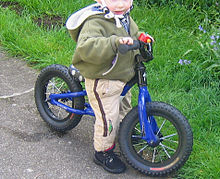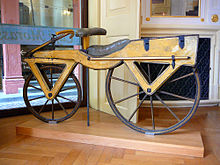Balance bike: Difference between revisions
m Reverted 1 edit by 120.150.108.189 (talk) to last revision by 99.245.248.91. (TW) |
WP:RELTIME "recent" is a nonsense in an encyclopedia. Be specific, say when if it is important, else leave it out. |
||
| Line 69: | Line 69: | ||
The first balance bicycle was the [[dandy horse]], and was invented by [[Karl Drais]], the earliest form of a two-wheeler - without pedals. His first reported ride from [[Mannheim]] to Rheinau (now a section of Mannheim) took place on June 12, 1817. Drais was a [[Germany|German]] [[inventor]] and invented the [[Laufmaschine]] ("running machine"), also later called the [[velocipede]], ''[[draisine]]'' ([[English language|English]]) or "draisienne" ([[French language|French]]), or nicknamed, [[dandy horse]]. This incorporated the two-wheeler principle that is basic to the [[bicycle]] and [[motorcycle]] and meant the beginning of mechanized personal transport. |
The first balance bicycle was the [[dandy horse]], and was invented by [[Karl Drais]], the earliest form of a two-wheeler - without pedals. His first reported ride from [[Mannheim]] to Rheinau (now a section of Mannheim) took place on June 12, 1817. Drais was a [[Germany|German]] [[inventor]] and invented the [[Laufmaschine]] ("running machine"), also later called the [[velocipede]], ''[[draisine]]'' ([[English language|English]]) or "draisienne" ([[French language|French]]), or nicknamed, [[dandy horse]]. This incorporated the two-wheeler principle that is basic to the [[bicycle]] and [[motorcycle]] and meant the beginning of mechanized personal transport. |
||
More recently, wooden and metal balance bikes have undergone somewhat of a renaissance with the introduction of several new models.{{Citation needed|date=June 2011}} |
More recently{{When}}, wooden and metal balance bikes have undergone somewhat of a renaissance with the introduction of several new models.{{Citation needed|date=June 2011}} |
||
==References== |
==References== |
||
{{Reflist}} |
|||
<references/> |
|||
<!--======================== {{No more links}} ============================ |
<!--======================== {{No more links}} ============================ |
||
Revision as of 15:28, 25 May 2013
This article needs additional citations for verification. (March 2011) |

A balance bicycle, or run bike is a training bicycle that helps children learn balance and steering. It has no pedals, no crankset and chain, and no training wheels.
Designs

Balance bikes have been made out of both metal and wood. It can be a normal bicycle with pedals and related parts removed, or it can be purpose-built (especially for very small children, for whom normal bicycles are generally not available). It can have no brake, or it can have one or two hand-activated rim brakes.
To function properly, a balance bicycle must be small enough that the rider can walk the bicycle while sitting comfortably in the saddle, putting both feet flat on the ground. The rider first walks the bicycle while standing over the saddle, then while sitting in the saddle. Eventually, the rider feels comfortable enough to run and "scoot" while riding the bicycle, then to lift both feet off the ground and cruise while balancing on the two wheels.
Learning method
Manufacturers of balance bicycles say that children can learn to bicycle faster because they learn to balance and countersteer first and then to pedal later, and that training wheels slow learning because kids become too dependent on them, acquiring bad habits.[1][2] Pediatricians say that there is no evidence that children learn to bike faster without training wheels.[1][3] Training wheels that prevent the bike from leaning also prevent countersteering, so that, as with a tricycle, kids learn to turn the handlebars the wrong way, which must be unlearned later.[4] Sheldon Brown wrote that training wheels can become an obstacle to learning if they are adjusted incorrectly, because they prevent the bike from leaning if they are too low, and can inhibit braking if too much weight is taken off the rear wheel by training wheels that are too low.[5] Adjusting training wheels correctly, and raising them higher as the child's skill increases, avoids these problems.[5] Balance bikes with no brakes at all except the rider's feet might stop poorly as well, though very young children might not use brakes effectively anyway.[3] Brown recommended simply removing the pedals from a normal, kid's bicycle, avoiding the extra expense of a balance bike,[5] and parents have had success with this approach.[1][6][7]
History

The first balance bicycle was the dandy horse, and was invented by Karl Drais, the earliest form of a two-wheeler - without pedals. His first reported ride from Mannheim to Rheinau (now a section of Mannheim) took place on June 12, 1817. Drais was a German inventor and invented the Laufmaschine ("running machine"), also later called the velocipede, draisine (English) or "draisienne" (French), or nicknamed, dandy horse. This incorporated the two-wheeler principle that is basic to the bicycle and motorcycle and meant the beginning of mechanized personal transport.
More recently[when?], wooden and metal balance bikes have undergone somewhat of a renaissance with the introduction of several new models.[citation needed]
References
- ^ a b c Athavaley, Anjali (1 September 2010), "Look Ma, No Pedals! --- Ditch the Training Wheels, New Bikes Promise a Faster Way to Learn", Wall Street Journal, New York, NY, p. D.1
- ^ Kolpack, Dave (7 June 2010), "South Dakota man sells training bikes for tykes", Bloomberg BusinessWeek, retrieved 2011-06-07
- ^ a b McLean, Catherine (22 May 2011), "Look ma, no pedals! Balance bikes hit Canada", Globe and Mail, retrieved 2011-06-07
- ^ Heine, Jan (February 2011), "Cornering on a Bicycle; Master centrifugal force on curves" (PDF), Adventure Cyclist, Adventure Cycling Association, retrieved 2011-12-26
- ^ a b c Brown, Sheldon (3 May 2010), Teaching Kids To Ride, retrieved 2011-06-07
- ^ Juedes, Joy (26 July 2010), "Two-wheel training", Redlands Daily Facts, Redlands, California
- ^ Edwards, Drew (21 May 2011), "Putting the brakes on a parenting effort", Guelph Mercury, retrieved 2011-06-07
